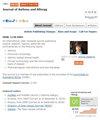教育水平改变挪威和瑞典的哮喘死亡率。北欧肺病研究
IF 3.7
3区 医学
Q2 ALLERGY
引用次数: 0
摘要
背景和目的:社会经济地位(SES)、哮喘和死亡率之间的关系是复杂和多方面的,教育水平是否会改变哮喘和死亡率之间的关系尚未确定。研究的目的是了解瑞典和挪威哮喘与死亡率之间的关系,以及教育水平在多大程度上改变了这种关系:在北欧肺病研究(Nordic EpiLung Study)中,有5.6万名年龄在30-69岁之间的人参加了2005-2007年期间在瑞典和挪威进行的有关哮喘和相关风险因素的人口调查。有关教育水平和 10 年全因死亡率的数据由国家当局进行关联。我们计算了哮喘导致的死亡风险比例,并采用 Cox 回归估算了按教育水平分层的哮喘相关死亡率的危险比 (HR) 和 95% 置信区间 (95%CI):在所有死亡病例中,共有5.5%的病例归因于哮喘。在对潜在的混杂因素进行调整后,与哮喘相关的死亡率为 1.71(95% CI 1.52-1.93)。与受过高等教育的人相比,受过初等教育的人因哮喘导致全因死亡的风险更高(HR 1.80,95% CI 1.48- 2.18;HR 1.39,95% CI 0.99- 1.95):哮喘导致全因死亡率总体上升 71%,5.5% 的死亡可归因于哮喘。教育水平改变了与哮喘相关的死亡风险,小学文化程度者的风险最高。本文章由计算机程序翻译,如有差异,请以英文原文为准。
Level of Education Modifies Asthma Mortality in Norway and Sweden. The Nordic EpiLung Study
Background and Aim: The relationship between socioeconomic status (SES), asthma and mortality is complex and multifaceted, and it is not established if educational level modifies the association between asthma and mortality. The aim was to study the association between asthma and mortality in Sweden and Norway and to what extent educational level modifies this association.
Participants and Methods: Within the Nordic EpiLung Study, > 56,000 individuals aged 30– 69 years participated in population-based surveys on asthma and associated risk factors in Sweden and Norway during 2005– 2007. Data on educational level and 10-year all-cause mortality were linked by national authorities. The fraction of mortality risk attributable to asthma was calculated, and Cox regression was used to estimate hazard ratios (HR) and 95% confidence intervals (95% CI) for mortality related to asthma, stratified by educational level.
Results: In total, 5.5% of all deaths was attributed to asthma. When adjusted for potential confounders, the HR for mortality related to asthma was 1.71 (95% CI 1.52– 1.93). Those with primary level of education had higher hazard of all-cause death related to asthma than those with tertiary level (HR 1.80, 95% CI 1.48– 2.18, vs HR 1.39, 95% CI 0.99– 1.95).
Conclusion: Asthma was associated with an overall 71% increased all-cause mortality and 5.5% of deaths can be attributed to asthma. Educational levels modified the risk of mortality associated with asthma, with the highest risk among those with primary education.
Keywords: epidemiology, cohort, prognosis
Participants and Methods: Within the Nordic EpiLung Study, > 56,000 individuals aged 30– 69 years participated in population-based surveys on asthma and associated risk factors in Sweden and Norway during 2005– 2007. Data on educational level and 10-year all-cause mortality were linked by national authorities. The fraction of mortality risk attributable to asthma was calculated, and Cox regression was used to estimate hazard ratios (HR) and 95% confidence intervals (95% CI) for mortality related to asthma, stratified by educational level.
Results: In total, 5.5% of all deaths was attributed to asthma. When adjusted for potential confounders, the HR for mortality related to asthma was 1.71 (95% CI 1.52– 1.93). Those with primary level of education had higher hazard of all-cause death related to asthma than those with tertiary level (HR 1.80, 95% CI 1.48– 2.18, vs HR 1.39, 95% CI 0.99– 1.95).
Conclusion: Asthma was associated with an overall 71% increased all-cause mortality and 5.5% of deaths can be attributed to asthma. Educational levels modified the risk of mortality associated with asthma, with the highest risk among those with primary education.
Keywords: epidemiology, cohort, prognosis
求助全文
通过发布文献求助,成功后即可免费获取论文全文。
去求助
来源期刊

Journal of Asthma and Allergy
Medicine-Immunology and Allergy
CiteScore
5.30
自引率
6.20%
发文量
185
审稿时长
16 weeks
期刊介绍:
An international, peer-reviewed journal publishing original research, reports, editorials and commentaries on the following topics: Asthma; Pulmonary physiology; Asthma related clinical health; Clinical immunology and the immunological basis of disease; Pharmacological interventions and new therapies.
Although the main focus of the journal will be to publish research and clinical results in humans, preclinical, animal and in vitro studies will be published where they shed light on disease processes and potential new therapies.
 求助内容:
求助内容: 应助结果提醒方式:
应助结果提醒方式:


